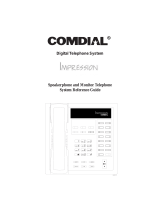
1.7 Understanding What the Lights Mean
The lights on your telephone indicate the status of lines, features, and
intercom.
— Next to a Direct Station Select (DSS)/ Busy Lamp Field
(BLF) button:
Steady red = station is in use.
Flashing red = station is receiving a call.
Winking red = message-waiting light set for you by station
associated with that DSS button.
— Next to a line button:
Steady green = line is in use at your station.
Steady red = line is in use at another station.
Flashing red = your line is ringing.
Flashing orange = your line is ringing and will be answered
when you lift the handset.
Winking green = line is on hold at your station.
Winking red = line is on hold at another station.
Fluttering orange = line has recalled from hold at your station.
Fluttering green = a second line has recalled from hold at your
station before you have answered the first recalling line
(fluttering orange).
Fluttering red = line has recalled from hold at another station.
— Next to a fixed feature or programmable feature button:
Steady red = the feature is on.
Steady off = the feature is off.
— Next to an INTERCOM button:
Steady green with a quick flash = you are using your intercom.
Winking red = a message is set on your telephone for
others to receive when calling.
Flashing orange = another station is calling you.
— Next to the HOLD button:
Fluttering red = message awaits pick up.
Winking green = a line is on hold at your station.
— Next to the SPEAKER button:
On steady (with telephone on hook and busy) = speakerphone
mode is active.
On steady (with telephone on hook and idle) = background
music is turned on.
Flashing = feature viewing and programming is in progress.
— Next to the MUTE button:
On steady = called party cannot hear your conversation.
Introducing the Telephone GCA70-314
1–6 Non-LCD Station User's Guide



























